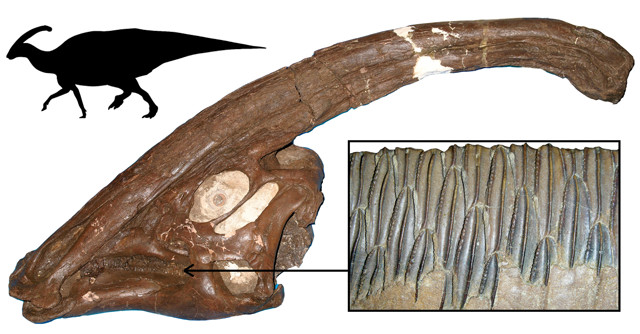
by Bethany Augliere Monday, October 17, 2016

A skull of the plant-eating hadrosaur, with its rows of teeth. Credit: ©School of Earth Sciences, University of Bristol.
Although the Tyrannosaurus rex might’ve been one of the most fearsome dinosaurs to roam Earth, it wasn’t the most common. That honor belonged to a group of vegetarian duck-billed dinosaurs called hadrosaurs. And now, scientists have uncovered the secret to their success: their teeth.
During the Mesozoic Era, the giant plant-eating ornithopods, which included hadrosaurs, dominated the landscape on every continent. But near the end of the Mesozoic, in the Late Cretaceous, the duck-billed dinosaurs exploded in diversity. They accounted for roughly 40 percent of all ornithopod species, so common that “some people call them the cows of the Cretaceous,” says Merrilee Guenther, a paleontologist at Elmhurst College in Illinois who was not involved in the new research.
Between 125 million and 80 million years ago, flowering plants were also evolving, which led to a radiation of terrestrial animals during that time. Researchers have long wondered whether hadrosaurs co-evolved alongside diversifying plants. “We wanted to test ideas about herbivorous dinosaurs and drivers of their diversification, but using proper numerical methods,” says Mike Benton, a paleontologist at the University of Bristol in England and co-author of the new study published in Scientific Reports.
So the researchers tracked ornithopod evolution, from the primitive species to the hadrosaurs, to test if their speciation occurred in response to plant diversification. They examined teeth and jaw bones from 112 species and looked at characteristics such as tooth density, shape, arrangement and number. “I like how they tackled that hypothesis in this study,” Guenther says. “I think it’s one of the first places where that was rigorously tested,” which was possible because of the abundance of hadrosaurs.
Benton’s team found that the megaherbivores went through four bursts of evolution. The first was among the basal ornithopods, the iguanodontians, during the Middle to Late Jurassic — well before flowering plants evolved. Primitive ornithopods had low tooth counts, spanning from 14 to 17 tooth pockets, and low tooth crowns, but iguanodontians had up to 20 teeth, which were larger, and more pointed than round.
However, the three other explosions in ornithopod diversity happened during the Late Cretaceous, when hadrosaurs arrived on the scene — long after the initiation of the radiation of flowering plants, the team reported.
Hadrosaurs had hundreds of teeth densely packed into a single flat surface, called a “dental battery,” says co-author Albert Prieto-Marquez, also from the University of Bristol. This allowed them to chew their food by sliding their jaws back and forth, unlike other dinosaurs, he says. And even though they radiated out into many species, their dental morphology remained the same. Their unique jaws and teeth allowed them to eat plants more efficiently, including the cones and pine needles of conifers, the team reported. “Diversity happened after they established these complex dental batteries as adaptations for feeding,” Prieto-Marquez says.
The findings suggest that the unique dental apparatus was driving the hadrosaurs’ success, rather than an adaptation to flowering plants, Prieto-Marquez says, because the bursts in evolution do not coincide in time with the changes in plants. Additionally, the habitats where hadrosaurs occurred had few angiosperms, and analysis of their stomach contents showed foliage from conifers, he says.
Hadrosaurs were the last dinosaurs to appear but then became the most prolific species, before they all went extinct 66 million years ago. Whether or not most dinosaurs were on the decline before the asteroid impact and Deccan flood basalts triggered the end-Cretaceous extinction is still up for debate, says Guenther, but this study shows that hadrosaurs were doing just fine, “which is not particularly surprising.” Next, the authors hope to track and analyze the evolution of additional ornithopod features, including their skulls.
© 2008-2021. All rights reserved. Any copying, redistribution or retransmission of any of the contents of this service without the expressed written permission of the American Geosciences Institute is expressly prohibited. Click here for all copyright requests.